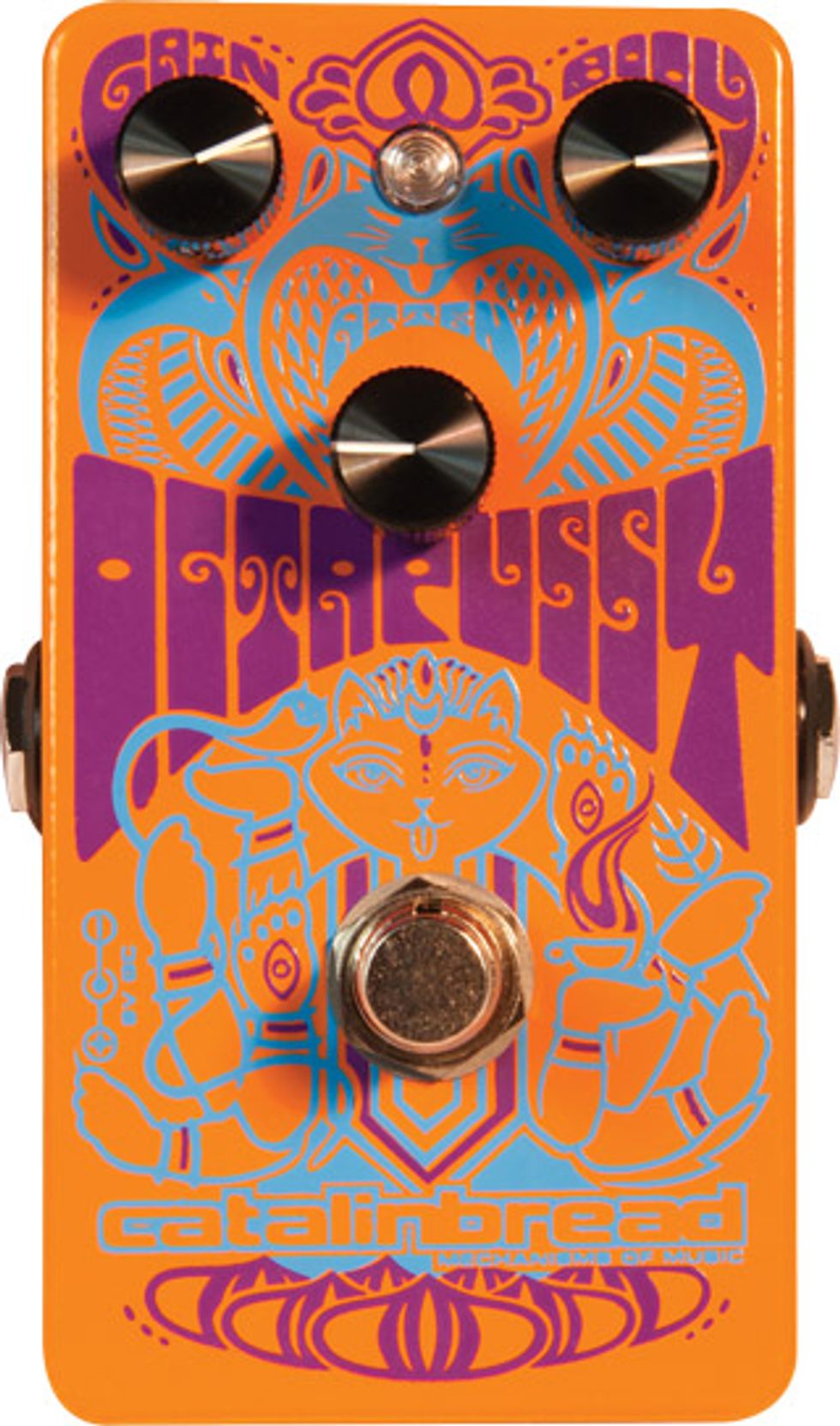While few among the unindoctrinated may realize it, octave fuzzes are responsible for some of the wildest and most famous rock-guitar tones ever. Hendrix’s iconic, Octavia tone defined hits

While few among the unindoctrinated may realize it, octave fuzzes are responsible for some of the wildest and most famous rock-guitar tones ever. Hendrix’s iconic, Octavia tone defined hits like “Purple Haze,” “Fire,” and “One Rainy Wish,” yet few listeners probably never knew they were hearing much more than an ordinary fuzz. An octave fuzz ranges from beautiful to ugly like few effects can. And they’ll sing, spurt, sputter, and scream with the best fuzzes when you set them up right. But they can also be a fight to control. The Octapussy, developed by Catalinbread, is designed to address many of those usability issues and offer some fresh, tonal variation on this venerable effect.
Purr-fectly Planned
Catalinbread designed the
Octapussy out of both love and
frustration with octave fuzz pedals
of the past. One of the primary
objectives was to infuse the
singing qualities of Octavia-type
effects with less compression,
which would kill picking dynamics
in many classic, octave fuzzes.
Avoiding the temptation to build another Octavia clone, Catalinbread designed an entirely new circuit from the ground up, and kept the signal path as simple and free of noise as possible. They also voiced to pedal to be more responsive to subtle changes in your guitar’s controls for volume, tone, and pickup selection, as well as how and where on the neck you play.
The resulting all-analog circuit is built around a core of three silicon transistors and a pair of diodes, and controlled by a trio of knobs for volume attenuation (atten), gain level (gain), and low-end response (body). The pedal can be powered by a 9V battery or a power supply set to 9 or 18 volts. And if you’re really particular (we’re talking persnickety here) about roadblocks to perfect tone, there’s also a switch inside to disable the LED indicator, which Catalinbread says improves pick attack and response—but at an amount that the company warns you might not be able to detect.
Double-O Fuzzin’
What sets the Octapussy apart
from most of its contemporaries
is how utterly easy and fluid it
feels to play with. The pedal
responds very naturally to pickup
and volume control changes,
so getting used to using the
guitar as an additional set of
controls is key to getting the
most from the Octapussy.
Ratings
Pros:
Extremely responsive and dynamic octave-fuzz
tones.
Cons:
Some may not be comfortable with having to
play with their guitar’s controls so much to get to the
pedal’s best tones.
Tones:
Ease of Use:
Build:
Value:
Street:
$179
Catalinbread
catalinbread.com
The Octapussy feels perfectly at home with humbuckers and single-coils alike, but it seems to really open up with the likes of a Stratocaster. Striking single notes with the gain and body controls maxed yields an extraordinarily fluid tone that sustains very easily, and blossoms into a shower of upper-end harmonics that rain with greater intensity the longer you hold bent notes. Dropping the guitar’s volume knob about halfway melts the fat off of the tone, revealing crisp, saccharine-sweet tones that are still very harmonically rich. But the real magic happens when you flip to the Stratocaster’s neck single-coil, roll off the tone knob, and play melodic leads above the 12th fret—which results in velvety smooth mids and highs that have beautiful and natural decay, but sing louder and stronger when you dig into the strings harder.
Thick and dynamic octave-up fuzz isn’t the only thing that the Octapussy excels at. For decades, guitarists have used octave fuzzes for faux ring-modulation tones by lowering the guitar’s volume and playing droning notes with the melody. The Octapussy behaves in the same fashion, but with more pronounced ring-like effects than most. Setting the guitar’s volume knob about a 1/4 turn up with the bridge pickup and the tone control maxed will deliver the most familiar version of the effect, but playing different points along the string length with different pickups will result in a palate of strange and otherworldly tones—like sitar-type sounds when you pick close to the bridge, and horn tones from the low E and A strings on the neck pickup when you roll the tone back and forth.
The Verdict
The Octapussy is a stellar choice
for guitarists in search of an
octave fuzz that’s clearer and more
responsive. Granted, coaxing out
its better tones assumes that you’re
comfortable with working with
your guitar’s controls pretty heavily,
but the results are well worth
the effort. This is a very musical
pedal, and when you approach it
with the intent to go beyond the
most obvious use of octave fuzz, it
can yield a world of very cool and
very unexpected results.

